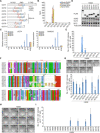Reprogramming competence of OCT factors is determined by transactivation domains
- PMID: 32917606
- PMCID: PMC7467702
- DOI: 10.1126/sciadv.aaz7364
Reprogramming competence of OCT factors is determined by transactivation domains
Abstract
OCT4 (also known as POU5F1) plays an essential role in reprogramming. It is the only member of the POU (Pit-Oct-Unc) family of transcription factors that can induce pluripotency despite sharing high structural similarities to all other members. Here, we discover that OCT6 (also known as POU3F1) can elicit reprogramming specifically in human cells. OCT6-based reprogramming does not alter the mesenchymal-epithelial transition but is attenuated through the delayed activation of the pluripotency network in comparison with OCT4-based reprogramming. Creating a series of reciprocal domain-swapped chimeras and mutants across all OCT factors, we clearly delineate essential elements of OCT4/OCT6-dependent reprogramming and, conversely, identify the features that prevent induction of pluripotency by other OCT factors. With this strategy, we further discover various chimeric proteins that are superior to OCT4 in reprogramming. Our findings clarify how reprogramming competences of OCT factors are conferred through their structural components.
Copyright © 2020 The Authors, some rights reserved; exclusive licensee American Association for the Advancement of Science. No claim to original U.S. Government Works. Distributed under a Creative Commons Attribution NonCommercial License 4.0 (CC BY-NC).
Figures






References
-
- Takahashi K., Tanabe K., Ohnuki M., Narita M., Ichisaka T., Tomoda K., Yamanaka S., Induction of pluripotent stem cells from adult human fibroblasts by defined factors. Cell 131, 861–872 (2007). - PubMed
-
- Nakagawa M., Koyanagi M., Tanabe K., Takahashi K., Ichisaka T., Aoi T., Okita K., Mochiduki Y., Takizawa N., Yamanaka S., Generation of induced pluripotent stem cells without Myc from mouse and human fibroblasts. Nat. Biotechnol. 26, 101–106 (2008). - PubMed
-
- Maekawa M., Yamaguchi K., Nakamura T., Shibukawa R., Kodanaka I., Ichisaka T., Kawamura Y., Mochizuki H., Goshima N., Yamanaka S., Direct reprogramming of somatic cells is promoted by maternal transcription factor Glis1. Nature 474, 225–229 (2011). - PubMed
-
- Malik V., Glaser L. V., Zimmer D., Velychko S., Weng M., Holzner M., Arend M., Chen Y., Srivastava Y., Veerapandian V., Shah Z., Esteban M. A., Wang H., Chen J., Schöler H. R., Hutchins A. P., Meijsing S. H., Pott S., Jauch R., Pluripotency reprogramming by competent and incompetent POU factors uncovers temporal dependency for Oct4 and Sox2. Nat. Commun. 10, 3477 (2019). - PMC - PubMed
Publication types
LinkOut - more resources
Full Text Sources
Other Literature Sources
Molecular Biology Databases
Research Materials

